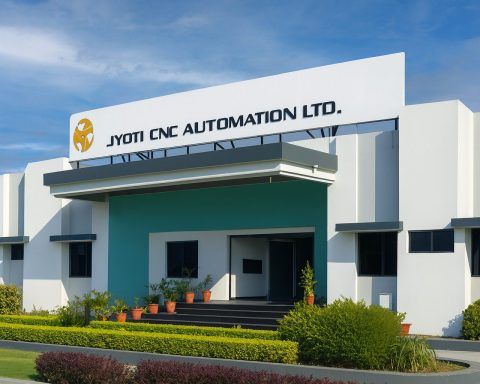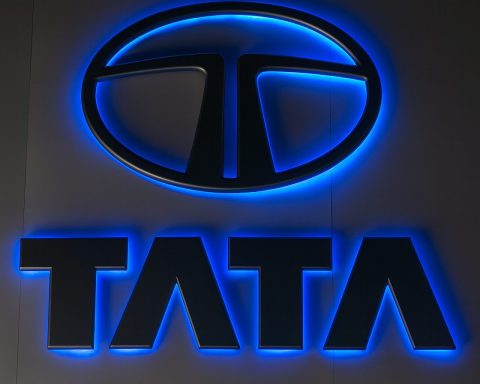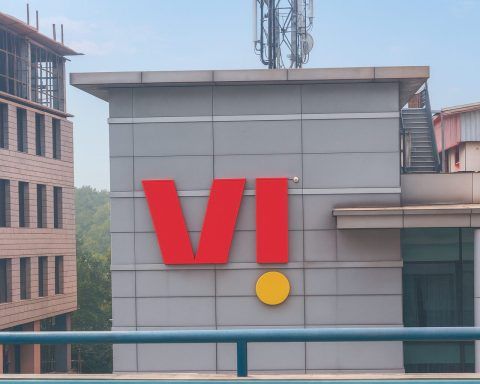- By Aug. 7, 2025, the Nasdaq Composite reached a record peak driven by chipmakers and AI stocks.
- OpenAI launched GPT-5 in August 2025 amid a push for ROI in AI.
- AMD fell about 5% and SMCI dropped over 18% on Aug. 6–7 after data-center results disappointed, while AMD’s Q2 data-center revenue rose 14% to $3.2 billion, lagging Nvidia’s 73% surge in the same segment.
- Palantir (PLTR) surged nearly 9% in a day after Aug. 5, as it raised its full-year revenue forecast for the second time in 2025, with Q2 revenue of $1 billion and government sales up 53%.
- Meta Platforms wired a $29 billion AI data-centers financing with PIMCO and Blue Owl, and outlined megaprojects Prometheus and Hyperion, with the first data center online in 2026.
- Alphabet, Meta, Amazon, and Microsoft are on pace to spend nearly $400 billion this fiscal year on AI data centers and related capex.
- SoftBank Group jumped over 13% to a record high in Tokyo on Aug. 8, 2025 after reporting ¥421.8 billion in Q2 net profit and reaffirming its AI push, including a $30 billion OpenAI stake and leading financing for a $500 billion Stargate AI data-center project.
- SoftBank’s rally helped push Japan’s Topix index above 3,000 for the first time.
- In China, robotics stocks rallied ahead of the World Robotics Conference starting Aug. 8, 2025, with robotics-related shares up 27.3% year to date; Zhongda Dali up 191% and Shanhe Intelligence up 130%.
- Ambiq Micro jumped 61% in its trading debut in early August 2025, and CoreWeave filed for what could be 2025’s biggest tech IPO, aiming for a valuation north of $30 billion.
Global markets surged on AI hype in early August 2025, with major indexes hitting highs and AI-focused companies dominating headlines. In the U.S., the tech-heavy Nasdaq Composite rallied to a record peak by Aug. 7 amid strength in chipmakers and AI plays [1]. Investors cheered blockbuster earnings and bold AI initiatives from industry leaders – from semiconductor firms to cloud giants and enterprise software providers – even as a few disappointments tempered the euphoria. Meanwhile, global markets echoed the trend: Japan’s SoftBank hit all-time highs on its AI bets, and China’s “robotics” stocks skyrocketed. Below is a detailed roundup of the key AI stock news and developments from August 7–8, 2025, across sectors and regions.
Semiconductors & AI Hardware: High Hopes Meet Mixed Results
Chip stocks have been at the epicenter of the 2025 AI boom, but the latest earnings brought a reality check. Advanced Micro Devices (AMD) and server-maker Super Micro Computer (SMCI) – both seen as AI beneficiaries – tumbled after reporting underwhelming data-center results, shaking confidence in their AI growth stories [2]. AMD’s stock slid ~5%, while SMCI plunged over 18% on Aug. 6–7 [3], erasing some of their huge year-to-date gains.
Analysts noted AMD’s data-center revenues (which include its AI accelerator chips) rose 14% to $3.2 billion in Q2, slightly below expectations, and paled next to rival Nvidia’s 73% surge in the same segment [4]. Jefferies analysts remarked that AMD’s AI outlook didn’t show the upside some hoped for [5]. CEO Lisa Su acknowledged U.S. export restrictions on advanced MI308 AI chips to China hurt sales [6], and HSBC warned that any reversal of the ban is likely “more muted” than markets anticipated [7]. This underscores how geopolitics and supply issues can cap near-term AI chip growth.
SMCI, a leading AI server manufacturer (and often seen as a “proxy” for Nvidia), also missed forecasts and hinted it’s losing market share to larger rivals Dell and HPE in the red-hot AI server market [8]. The company’s execution missteps and Nvidia chip supply delays squeezed margins, prompting a guidance cut [9]. Given the sky-high expectations, any perceived weakness can trigger sharp backlash – “any weakness in the high-expectation AI space tends to spark sharp investor backlash,” cautioned one analyst [10]. Indeed, $6 billion+ in SMCI market value evaporated in one day [11] [12].
Despite these hiccups, long-term enthusiasm remains strong. Over 70% of SMCI’s revenue now comes from AI platforms, and J.P. Morgan reiterated that AI is the “preeminent driver of sales growth” for the company [13] [14]. Likewise, Bank of America analysts noted the broader chip sector still has positive tailwinds, especially as U.S. policy developments (like potential tariff exemptions for domestic manufacturing) alleviate some concerns [15] [16]. In recent trading, AI chip giants Nvidia and Broadcom hit new highs, and even AMD rebounded 5% amid optimism that looming 100% chip tariffs would spare firms investing in U.S. plants [17]. Investor takeaway: the AI semiconductor rally is intact, but selectivity is rising – companies must deliver on big expectations or face swift corrections.
Cloud AI & Data Centers: Big Tech’s $400 Billion Bet on AI Infrastructure
As demand for AI computing explodes, cloud and tech titans are pouring unprecedented capital into AI infrastructure. In fact, the four largest players – Alphabet, Meta, Amazon, and Microsoft – together are on pace to spend nearly $400 billion this fiscal year (combined) on data centers and other AI-related capex [18]. Recent developments on Aug 7–8 underscored this arms race to build “AI supercomputers” in the cloud.
Meta Platforms (Facebook) made waves with a massive financing deal for new AI data centers. Meta has tapped PIMCO and Blue Owl Capital to spearhead a $29 billion funding for expanding its data center footprint in rural Louisiana [19]. PIMCO will provide about $26 billion in debt (via bonds) while Blue Owl adds $3 billion equity [20] – a huge vote of confidence in Meta’s AI ambitions. The move comes as Meta seeks partners to shoulder its AI infrastructure push; just last week Meta revealed plans to offload ~$2 billion in existing data center assets as part of a co-development strategy to share the cost of generative AI facilities [21]. CEO Mark Zuckerberg has been explicit that Meta will spend “hundreds of billions of dollars” building out “massive” AI supercomputing hubs [22]. He announced plans for multiple new mega–data centers (codenamed “Prometheus” and “Hyperion”) capable of gigawatt-scale power to support Meta’s AI “superintelligence” project, with the first coming online in 2026 [23]. This extraordinary scale – effectively creating AI factories – illustrates how critical cloud AI is to Meta’s future, and why it’s leveraging external capital to get there.
Meta’s not alone. Every cloud provider is racing to expand AI capacity. Alphabet’s Google and Amazon’s AWS have similarly boosted spending on AI data centers and custom chips, while Microsoft (which backs OpenAI) is investing heavily to support services like ChatGPT. Even hardware firms are jumping in: SoftBank Group (Japan), better known as an investment conglomerate, announced it is leading financing for “Stargate” – a $500 billion AI data center project in the U.S. [24]. SoftBank is committing vast sums to AI (including $30 billion into OpenAI) and clearly sees infrastructure as key to that strategy [25]. These colossal projects highlight a new reality: cloud AI at scale requires cloud-scale money.
Despite the hefty price tags, investors remain enthusiastic that these bets will pay off. The flurry of funding deals and buildouts suggests an expected long-term shortage of AI compute, which could favor the best-prepared players. As evidence of the optimism, data center chip suppliers and equipment makers (like TSMC and ASML) have noted robust orders even as they navigate geopolitics [26]. In short, Big Tech is treating AI like the next electricity – an essential utility – and are open-checkbook investing to dominate that future.
Enterprise AI Software: Palantir’s Soaring Demand & “Insatiable” AI Appetite
The enterprise AI software segment saw perhaps the most dramatic stock moves of the week, led by Palantir Technologies (PLTR). Palantir – a provider of data analytics and AI platforms – delivered blowout Q2 results that sent its stock up nearly 9% in one day [27], capping a rally that already made it 2025’s best-performing S&P 500 stock. On Aug. 5, the company raised its full-year revenue forecast for the second time this year, citing “soaring” demand for its AI-driven solutions from both government and commercial clients [28]. Palantir’s military-grade AI and defense contracts (including new U.S. Army deals potentially worth $10 billion over a decade) are a major growth engine [29] [30]. Government sales jumped 53% last quarter, helping quarterly revenue hit $1 billion for the first time [31]. Investors have responded by betting big on Palantir’s AI story – the stock has doubled in 2025, and surged over 600% in the past three years, far outpacing most tech peers [32].
Bullish commentary is pouring in. “Palantir isn’t just a gov’t vendor anymore – it’s becoming an indispensable partner for enterprises in the AI revolution,” said Saxo Bank’s head of strategy [33]. Wedbush Securities analysts went so far as to predict Palantir could hit a $1 trillion market cap within a few years, riding the AI wave (for context, Palantir is about $380 billion now) [34]. Such optimism reflects a broader sentiment on Wall Street that AI software and cloud firms have tremendous runway as businesses adopt generative AI, predictive analytics, and automation tools.
However, the frenzy has also raised valuation red flags. At current prices, Palantir trades above 200× forward earnings – the priciest valuation in the S&P 500 – versus, for example, Nvidia at ~35× [35]. “Despite [Palantir’s] robust competitive advantages…we believe this is turning into a difficult-to-justify valuation story,” cautioned analysts at Morningstar, who worry investors may be getting ahead of fundamentals [36]. Palantir itself noted that expenses will rise in coming quarters as it aggressively hires AI talent – at the same time that Big Tech is in an arms race for AI engineers, driving up costs [37]. This mirrors a trend across the industry: while revenue is booming, AI labor and compute are expensive, and profit leverage remains a question.
Overall, though, sentiment in enterprise tech remains extremely bullish. Many software CEOs are calling this the dawn of a new tech cycle. For example, Oracle co-founder Larry Ellison recently proclaimed, “AI is a much bigger deal than the Industrial Revolution, electricity, and everything that’s come before.” He said demand is “almost insatiable” for AI products, after Oracle saw clients pouring into its AI cloud services [38]. Likewise, Microsoft, Google, Salesforce, and others have all highlighted multi-billion-dollar opportunities in AI during recent earnings. This kind of executive exuberance – coupled with tangible growth numbers – has kept investors piling into enterprise AI names. Even smaller AI software firms (from fintech to cybersecurity) are attracting speculative inflows. The key question is not if but how fast AI adoption will monetize. For now, as Palantir’s surge shows, markets are rewarding those showing real traction in AI, while keeping an eye on the froth factor.
Robotics & Global AI Highlights: SoftBank’s Record Surge and China’s Robot Rally
The AI fervor isn’t confined to the U.S. software and chips arena – it’s truly global, even extending into robotics and automation stocks. In Japan, conglomerate SoftBank Group – famed for its tech investments – experienced a historic stock surge on Aug. 8. SoftBank’s shares soared over 13% to a record high in Tokyo trading [39] after the company posted a blockbuster quarterly profit and touted its AI-focused strategy. For the April–June quarter, SoftBank reported ¥421.8 billion (≈$2.87 billion) in net profit, a dramatic swing from a loss a year earlier [40]. The earnings beat, driven by improved performance in its tech investment portfolio, was seen as vindication of CEO Masayoshi Son’s aggressive pivot to AI. The company noted that market enthusiasm for AI had lifted valuations for many of its holdings – both public and private – improving SoftBank’s own leverage ratios [41].
SoftBank has indeed gone all-in on AI. In recent months it committed $30 billion to OpenAI (maker of ChatGPT) and led financing for the “Stargate” $500 billion AI data-center project in the U.S. [42]. These “mammoth investments,” as Reuters termed them, underscore SoftBank’s aim to be at the center of the AI revolution. Macquarie analyst Paul Golding wrote that SoftBank’s results are “evidence of [its] quality diversified portfolio, strong fundamentals, [and] secular AI tailwinds”, praising the firm’s positioning [43]. Investors agreed: SoftBank’s surge single-handedly pushed Japan’s Topix index above 3,000 points for the first time ever [44]. “Active investors scooped up SoftBank shares to beat the Topix’s gain,” noted one Tokyo market analyst, as fund managers rushed to grab the AI winner [45]. SoftBank’s rally provided a huge boost of confidence to Asia’s tech markets, reinforcing how major AI bets are lifting entire indices.
Over in China, an AI-driven robotics boom is underway in equities. The 2025 World Robotics Conference kicked off in Beijing on Aug. 8, and Chinese “robot concept” stocks have been on fire leading up to it. On average, China’s listed robotics-related companies are up 27.3% year-to-date, with some skyrocketing even more [46]. Two notable examples are Zhongda Dali and Shanhe Intelligence, whose shares have surged 191% and 130% respectively this year [47] – astonishing gains reflecting intense excitement around automation and AI. Dozens of Chinese robot makers have issued strong mid-year earnings forecasts; at least 14 reported year-over-year profit growth in the first half, and several that were loss-making in 2024 are expected to swing to profitability thanks to demand for smart robots [48]. For instance, industrial robotics firm Dongfang Seiko projected its H1 net profit will double from a year ago [49]. This flurry of positive news, combined with the high-profile robotics expo, has created a feeding frenzy in China’s market for anything AI or robot-related. It mirrors the “AI bubble” atmosphere – but backed by real signs of sector growth.
It’s worth noting that robotics stocks globally are benefiting from the broader AI trend as well. In the U.S. and Europe, companies that enable automation – from industrial robot makers to AI vision system providers – have seen increased investor interest. For example, Nvidia (which provides robotics development platforms) and automation leaders like ABB have highlighted rising sales for AI-driven robotics and factory automation tools. While the Chinese rally is the most extreme case, it underscores a key point: AI is not just about software – it’s also about the physical automation of tasks via robots and smart machines. That theme is resonating in factories, warehouses, and even fast-food kitchens, and investors are keen to identify the next winners in this space.
Investor Sentiment: Euphoria With a Side of Caution
Across the board, the early August news cycle showed investor sentiment on AI remains extremely bullish, albeit with a few nascent cautionary notes. Euphoria is evident in how markets rewarded AI-focused announcements – record stock prices, oversubscribed funding deals, and aggressive price targets. Big Tech executives are evangelizing AI as the future (with near-religious zeal, in Ellison’s case), and Wall Street analysts are mostly raising forecasts. The fact that many AI stocks are at or near all-time highs (from Nvidia and Broadcom to Palantir and Salesforce) speaks to the FOMO – fear of missing out – driving money into the theme.
At the same time, some seasoned voices are urging discernment. The steep drops in AMD and Super Micro after earnings illustrate that this market will punish hype that isn’t met with concrete results [50] [51]. The valuation debate around Palantir shows not everyone is willing to justify infinite multiples purely on AI potential [52]. And in a thoughtful commentary, Cabot Wealth’s Jacob Mintz mused whether the “AI trade has become too easy”, noting signs of froth such as call-option frenzy in speculative AI names and lagging performance in non-tech sectors [53] [54]. His “spider sense” wonders if we’re in the later innings of a hype cycle or still just the early stages [55] – a question no one can answer with certainty.
For now, the momentum and news flow remain overwhelmingly positive for AI-related stocks. Even new IPOs in the sector are thriving: e.g., Ambiq Micro, a small AI chipmaker, soared 61% in its trading debut this week [56], and CoreWeave – a cloud AI provider backed by Nvidia – has filed for what could be one of 2025’s biggest tech IPOs, aiming for a valuation north of $30 billion [57] [58]. The pipeline of private AI unicorns eyeing public markets (from design software to fintech AI firms) suggests investor appetite is still growing. M&A activity is also bubbling, with both strategic tech companies and private equity hunting for AI-driven targets (e.g. Blackstone’s recent $enverus energy AI deal, and numerous small AI software acquisitions announced in early August).
Bottom line: The first week of August 2025 demonstrated that AI remains the defining theme on Wall Street. Whether it’s trillion-dollar mega-caps or newly public startups, companies tied to artificial intelligence are in the spotlight and, for the most part, in the winner’s column. As one analyst put it, demand for AI feels “insatiable” right now [59]. Investors are riding that wave – but they’ll be watching upcoming earnings and economic signals closely. The true test will be sustaining growth to justify valuations. In the meantime, the AI stock frenzy rolls on, fueled by breakthroughs like GPT-5’s launch and the promise that this tech revolution is just getting started. Every new chip, data center, and algorithm is another step into what many call the new age of AI-driven opportunity – and markets are responding in kind.
Sources:
- Reuters – SoftBank shares hit record on AI optimism [60] [61] [62]
- Reuters – OpenAI launches GPT-5 amid push for ROI [63] [64]
- Reuters – AMD & Super Micro slide as AI server growth disappoints [65] [66]
- Reuters – Palantir soars after raising outlook on “soaring” AI demand [67] [68]
- Reuters – Meta taps PIMCO/Blue Owl for $29 B AI data centers financing [69] [70]
- Zhitong Caijing via Webull – Chinese robot concept stocks surge ahead of conference [71]
- Cabot Wealth – “Has the AI trade become too easy?” (analyst commentary) [72] [73]
- Nasdaq/Zacks Market News – U.S. market index performance and tech rally context [74] [75]
References
1. www.investopedia.com, 2. www.reuters.com, 3. www.reuters.com, 4. www.reuters.com, 5. www.reuters.com, 6. www.reuters.com, 7. www.reuters.com, 8. www.reuters.com, 9. www.reuters.com, 10. www.reuters.com, 11. www.reuters.com, 12. www.reuters.com, 13. www.reuters.com, 14. www.reuters.com, 15. www.investopedia.com, 16. www.investopedia.com, 17. www.investopedia.com, 18. www.reuters.com, 19. www.reuters.com, 20. www.reuters.com, 21. www.reuters.com, 22. www.reuters.com, 23. www.reuters.com, 24. www.reuters.com, 25. www.reuters.com, 26. www.reuters.com, 27. www.reuters.com, 28. www.reuters.com, 29. www.reuters.com, 30. www.reuters.com, 31. www.reuters.com, 32. www.reuters.com, 33. www.reuters.com, 34. www.reuters.com, 35. www.reuters.com, 36. www.reuters.com, 37. www.reuters.com, 38. www.cabotwealth.com, 39. www.reuters.com, 40. www.reuters.com, 41. www.reuters.com, 42. www.reuters.com, 43. www.reuters.com, 44. www.reuters.com, 45. www.reuters.com, 46. www.webull.com, 47. www.webull.com, 48. www.webull.com, 49. www.webull.com, 50. www.reuters.com, 51. www.reuters.com, 52. www.reuters.com, 53. www.cabotwealth.com, 54. www.cabotwealth.com, 55. www.cabotwealth.com, 56. news.crunchbase.com, 57. www.reuters.com, 58. www.reuters.com, 59. www.cabotwealth.com, 60. www.reuters.com, 61. www.reuters.com, 62. www.reuters.com, 63. www.reuters.com, 64. www.reuters.com, 65. www.reuters.com, 66. www.reuters.com, 67. www.reuters.com, 68. www.reuters.com, 69. www.reuters.com, 70. www.reuters.com, 71. www.webull.com, 72. www.cabotwealth.com, 73. www.cabotwealth.com, 74. www.nasdaq.com, 75. www.nasdaq.com










